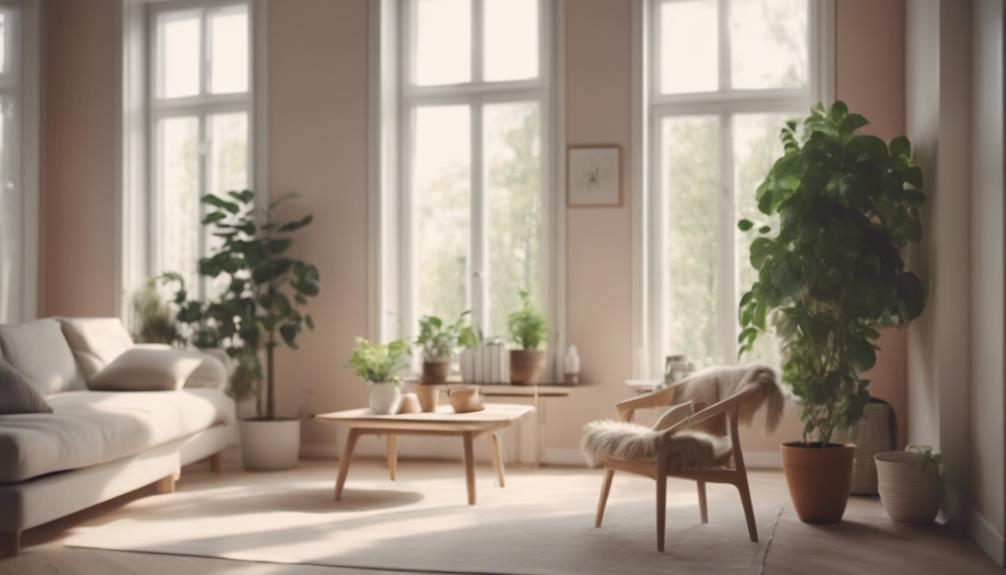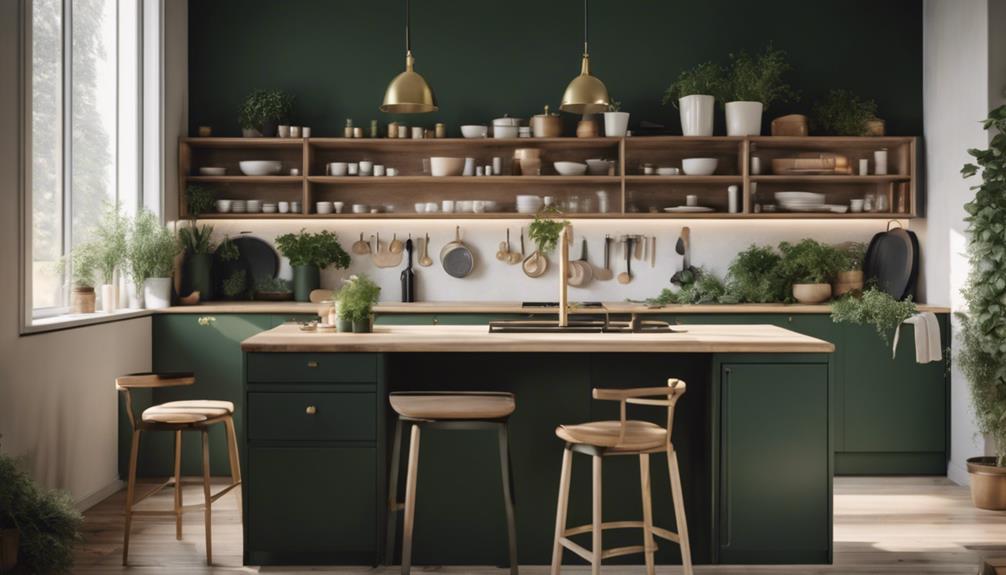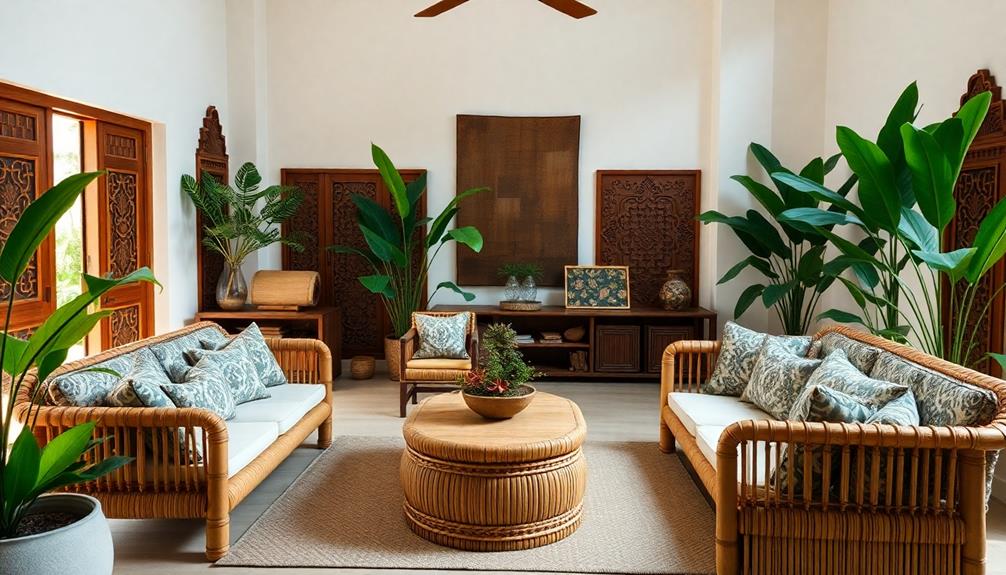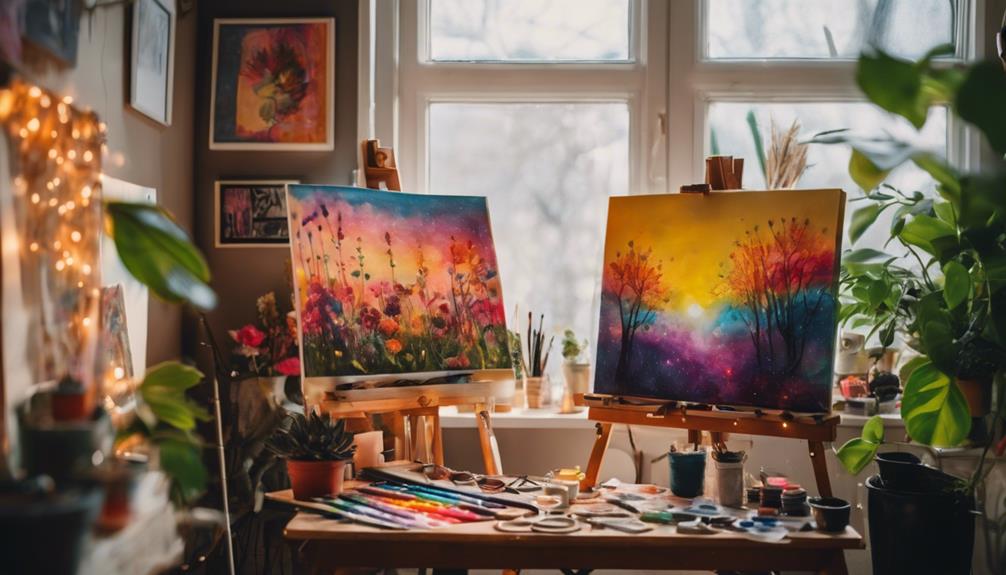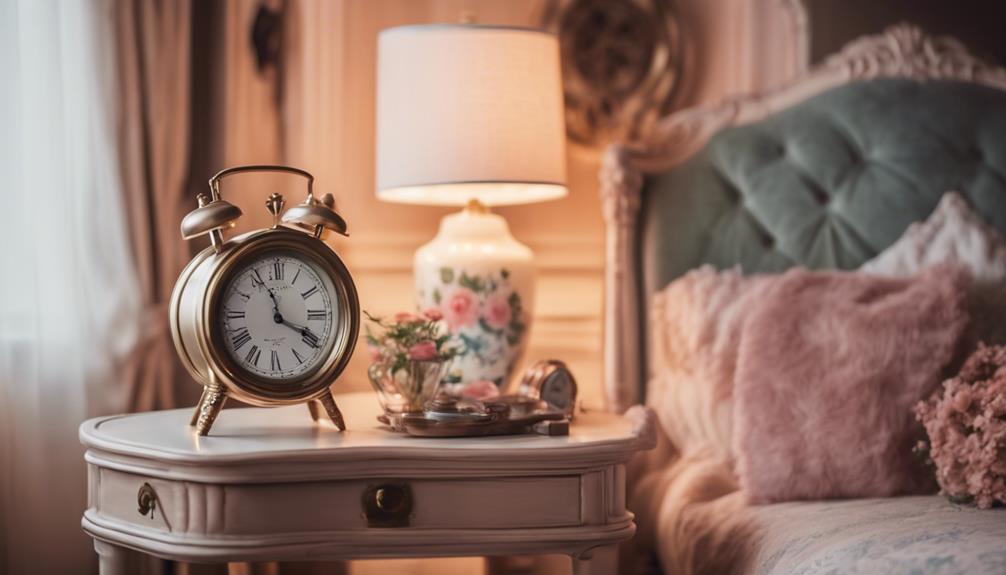In Scandinavian design, color psychology is key to fostering emotional well-being. You'll find that neutral palettes, like whites and warm grays, promote calmness, while soft blues add relaxation. Green plants balance the environment, and pops of brighter colors combat winter's gloom. These choices create serene atmospheres, enhancing your space's tranquility. Additionally, the use of natural materials complements these colors, reinforcing the connection to nature. It's more than aesthetics; it's about creating a comforting, inviting home. If you explore further, you'll discover how these principles align with the overall Scandinavian ethos of simplicity and functionality.
Key Elements
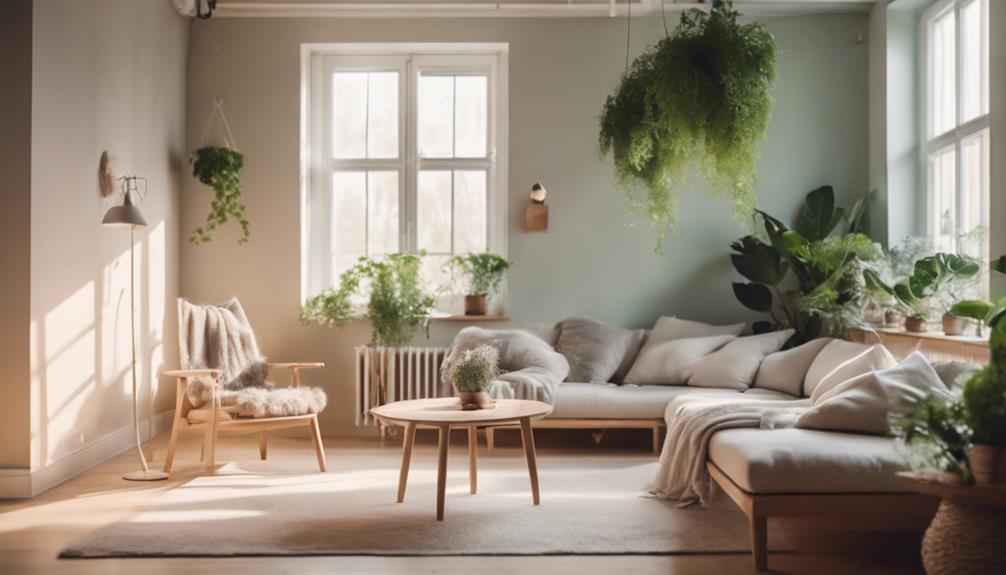
When you explore Scandinavian design, you'll notice how the color scheme, materials, and textures come together to create a harmonious environment.
Each element plays a vital role in establishing the emotional tone of the space, making it feel inviting and serene.
Understanding these key components will help you appreciate the thoughtful choices behind this style.
Color Scheme
Scandinavian design embraces a neutral color palette that fosters tranquility and enhances the perception of space. You'll often find whites, warm grays, and sandy hues creating a soothing backdrop in Scandinavian interiors. This neutral foundation promotes a calm atmosphere, making it easier to unwind after a long day.
To add depth while maintaining serenity, soft, dusky blues are frequently used as accent colors. These shades not only promote relaxation but also prevent the space from feeling too monotonous. Additionally, the growing trend of incorporating green reflects a desire for balance and freshness, often achieved through plants and botanical elements.
Bright colors, like pinks and yellows, are also strategically introduced to counteract the gloominess of long winters. These vibrant hues inject warmth and cheer into the minimalist aesthetic.
Color combinations in Scandinavian design aren't random; they're carefully chosen based on color psychology principles. Each hue is selected for its emotional effects, helping to create spaces that genuinely promote well-being. By using calming and soothing colors, Scandinavian design aims to create a sense of harmony and balance within the home. Neutrals like white, grey, and beige are often used as a base, with pops of muted, pastel tones added for a touch of warmth. By understanding the emotional impact of different colors, interior designers can create environments that encourage relaxation and comfort. To truly understand the power of color in Scandinavian design, one must discover the secrets of color psychology and its application in creating inviting and calming spaces. Scandinavian design often incorporates elements of nature, bringing in earthy tones like greens and browns to further enhance the sense of tranquility. By incorporating natural materials like wood and stone, the design is able to evoke a sense of rustic country decor, creating a warm and welcoming environment. These elements, combined with the carefully chosen color palette, work together to create a space that feels cozy and inviting, making it the perfect retreat from the stresses of everyday life.
Materials
Natural materials dominate Scandinavian design, infusing spaces with warmth and a sense of connection to the outdoors. You'll often find various types of wood, like pine, birch, and maple, forming the backbone of this aesthetic. These natural materials not only enhance the beauty of your interiors but also promote a cozy atmosphere that invites relaxation.
In addition to wood, organic materials such as wool and cotton are common, providing comfort while adhering to the simplicity and functionality that defines Scandinavian design. You might notice how these materials feature neutral colors, allowing the natural palette to shine through. This choice reflects a deep appreciation for the understated elegance that Scandinavian design embodies.
Another key element is the incorporation of glass, which maximizes natural light and creates a bright, airy feel in your spaces. This transparency complements the overall design philosophy, enhancing the sense of openness.
The use of rustic details, like weathered wood accents, adds character and reinforces that essential connection to nature. Overall, these materials work harmoniously to create inviting, serene environments that resonate with the principles of Scandinavian design.
Textures
Textures play an essential role in Scandinavian design, infusing spaces with warmth and inviting comfort through the use of materials like sheepskin, linen, and wool.
These natural textures not only enhance the aesthetic appeal of a room but also create a cozy atmosphere that promotes emotional well-being. By incorporating a variety of natural materials, such as rustic wood accents from birch and pine, you can add depth to minimalist interiors while reflecting the region's natural landscapes.
Opting for natural and undyed colors in textiles aligns with the Scandinavian emphasis on authenticity and simplicity. This choice not only highlights the textures but also adds a serene quality to your space.
Layering different textures, like soft pillows on a wooden bench, creates a harmonious balance essential for the hygge lifestyle.
In essence, the interplay of textures and natural colors fosters a calming environment, encouraging relaxation and comfort. When designing your space, consider how these elements work together to enhance not just the visual appeal, but also your overall emotional well-being.
Embrace the warmth and inviting nature of Scandinavian design through thoughtful texture choices.
Essential Fixtures and Furniture
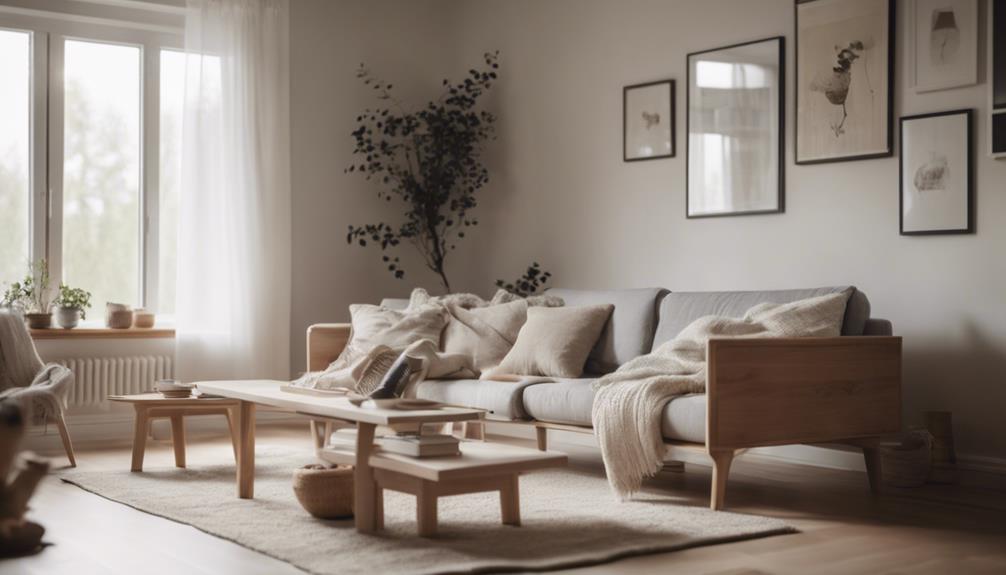
When you think about essential fixtures and furniture in Scandinavian design, consider the pieces that combine functionality with aesthetic appeal.
A Scandi-inspired dining table, accent chair, and coffee table can transform your space into a cozy haven.
These staples not only emphasize minimalism but also enhance the warm, inviting atmosphere typical of this style.
Scandi-Inspired Dining Table
A Scandi-inspired dining table combines minimalist design with functionality, making it the perfect centerpiece for any modern home. Typically crafted from natural materials like oak or birch, these tables emphasize a connection to nature, which is a hallmark of Scandinavian design. You'll notice clean lines that create a sense of openness, allowing your dining area to feel airy and inviting.
When setting your table, opt for simple, functional tableware in neutral colors. This choice not only aligns with the minimalist aesthetic but also provides a calming backdrop for vibrant accents, like colorful table runners or plates that can inject warmth and personality into your space.
Lighting is also essential; consider pendant lights or warm-colored table lamps to foster an inviting atmosphere, especially during long winter evenings. Additionally, you might want to incorporate multi-functional elements, like an extendable dining table, to accommodate both everyday meals and gatherings with friends.
Don't forget to add houseplants or floral centerpieces, which enhance the Scandi focus on natural elements and contribute to better indoor air quality. This thoughtful approach creates a harmonious dining experience you'll love.
Scandi-Inspired Accent Chair
Incorporating a Scandi-inspired accent chair into your space not only complements the minimalist dining table but also enhances the overall aesthetic with its clean lines and functional design. These chairs embody the essence of Scandinavian interior style, where simplicity meets comfort. A well-chosen accent chair can serve as a focal point, drawing attention while maintaining a serene ambiance.
Typically, these chairs feature a muted color palette, incorporating soft grays or pastel hues that seamlessly blend with other elements in your room. The use of natural materials like birch or oak paired with cozy textiles such as wool or linen adds warmth, inviting you to relax and enjoy your environment.
Iconic designs like Hans J. Wegner's Wishbone Chair or Arne Jacobsen's Egg Chair highlight the balance of form and function that defines Scandi style. By selecting a Scandi accent chair, you're not just adding furniture; you're creating a cozy, inviting space that reflects a connection to nature and the Scandinavian principles of design.
Embrace this aesthetic, and watch as your room transforms into a harmonious retreat.
Scandi-Inspired Coffee Table
Scandi-inspired coffee tables enhance your living space with their clean lines and natural materials, embodying the minimalist ethos of Scandinavian design. These tables often feature warm wood finishes or muted tones, fitting seamlessly into a neutral color palette that promotes an airy and calm atmosphere.
You'll find that many Scandi coffee tables are multifunctional, offering storage options or adjustable heights for added versatility. This adaptability makes them perfect for modern living, where space is often at a premium. You'll appreciate how their organic shapes or geometric designs create a harmonious connection to nature, aligning with the simplicity that Scandinavian design champions.
To maintain the minimalist ethos, accessorizing your coffee table is key. Curate decorative trays or a few well-chosen books to enhance functionality while keeping a clutter-free aesthetic. This intentional curation not only adds character but also adheres to the principles of Scandinavian design, ensuring your living space remains stylish and serene.
Lighting Ideas
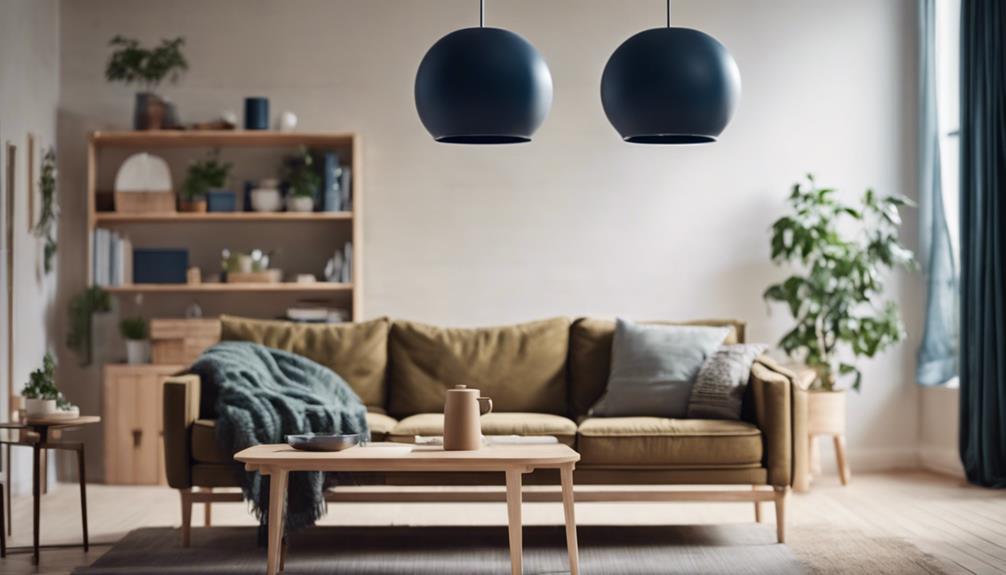
When it comes to lighting in Scandinavian design, you'll want to contemplate how different fixtures can enhance warmth and style.
Pendant lights with natural materials, soft glow table lamps, and candle-inspired wall sconces can create a cozy ambiance while serving as beautiful design elements.
Don't forget about natural fiber floor lamps, which add texture and warmth to any room.
Pendant Lights With Natural Materials
Pendant lights crafted from natural materials like wood and rattan instantly bring warmth and a touch of nature into your minimalist Scandinavian space. These lighting fixtures not only embody the principles of Scandinavian design but also enhance the cozy atmosphere essential for your home. With their clean lines and simple shapes, pendant lights made from organic materials promote a connection to nature while maintaining functionality and simplicity.
By choosing pendant lights that feature textures and finishes highlighting the natural imperfections of wood or rattan, you add character to your modern interiors. The soft, diffused lighting these fixtures provide is perfect for combating the long, dark winters common in Scandinavian regions, fostering a sense of well-being.
Additionally, opting for sustainable practices by incorporating eco-friendly pendant lights aligns with the growing demand for responsible design in contemporary homes. As you explore various styles, consider how these natural materials can elevate the aesthetic appeal of your space and create a warm, inviting environment.
Whether you're entertaining guests or enjoying a quiet evening at home, pendant lights with natural materials will enhance your Scandinavian design sensibilities, making your space feel both stylish and cozy.
Soft Glow Table Lamps
Soft glow table lamps complement the warmth of natural materials found in Scandinavian designs, enhancing your space with inviting illumination. These lamps are essential for creating a cozy atmosphere, especially against the backdrop of white walls that define many Nordic interiors. Their minimalist designs, often crafted from wood and metal, reflect the principles of Scandinavian design, emphasizing brightness and simplicity.
Incorporating soft glow table lamps into your home not only elevates your decor but also fosters a calming environment. The warm white light they emit counteracts the long, dark winters typical of Scandinavian countries, allowing you to enjoy a sense of tranquility and relaxation all year round.
These lamps excel at creating multiple lighting zones, giving you the flexibility to adjust the ambiance based on your needs. Whether you're reading a book, entertaining guests, or enjoying a quiet evening, soft glow table lamps enhance usability and comfort in any living space.
Candle-Inspired Wall Sconces
Embracing the warmth and charm of candle-inspired wall sconces can transform your living space into a cozy retreat that reflects the essence of Scandinavian design. These sconces emphasize minimalism with clean lines and simple forms, effortlessly enhancing the serene atmosphere characteristic of Nordic interiors.
By choosing candle-inspired wall sconces crafted from natural materials like wood or metal, you align your decor with the organic elements and craftsmanship central to Scandinavian aesthetics. The warm ambient lighting these sconces provide is perfect for creating an inviting environment, especially during those long, dark winters.
Many modern designs now incorporate energy-efficient LED candles, giving you the traditional glow of real candles while ensuring safety and longevity. To keep your space feeling cohesive, consider accent colors like muted greens or soft pastels, which complement the neutral palettes prevalent in Scandinavian decor.
This subtle warmth adds character without overwhelming the overall simplicity of your design. By integrating candle-inspired wall sconces into your home, you not only enhance the ambiance but also embrace the thoughtful, calming principles of Scandinavian design.
Natural Fiber Floor Lamps
Incorporating natural fiber floor lamps into your space not only enhances the aesthetic appeal but also fosters a warm and inviting atmosphere vital for Scandinavian design.
These lamps, crafted from materials like jute, rattan, or bamboo, highlight organic elements that create a calming, earthy vibe in your interiors. Their minimalist designs feature clean lines, making it easy for them to blend seamlessly into open spaces while maximizing natural light.
The warm glow emitted by natural fiber lamps contributes to a cozy ambiance, essential for combating the long, dark winters typical of Scandinavian climates. By integrating these pieces, you introduce texture into your room, adding visual interest without overwhelming the minimalist aesthetic that defines Scandinavian interiors.
Moreover, many natural fiber floor lamps are multifunctional, serving as both a light source and a stylish accent piece that enhances the overall harmony of your space. When you choose these lamps, you're not just lighting your home; you're embracing a lifestyle rooted in simplicity and comfort.
Decorative Elements
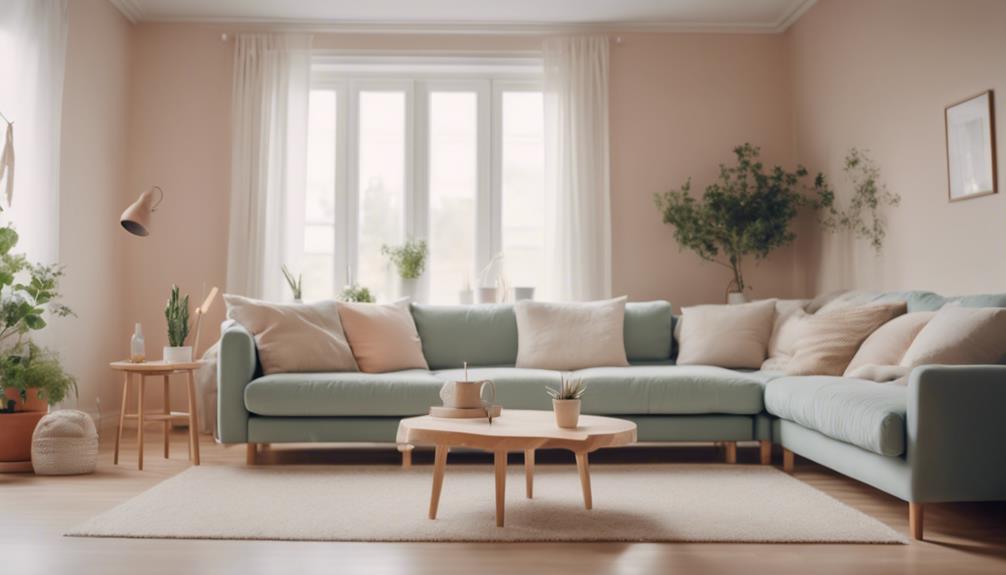
When you think about decorative elements in Scandinavian design, consider how a ceramic vase with earthy tones can ground your space.
Handwoven textile wall hangings add warmth and texture, while geometric wooden wall art introduces a modern touch.
These pieces not only enhance aesthetics but also create an inviting atmosphere that promotes well-being.
Ceramic Vase With Earthy Tones
A ceramic vase in earthy tones adds warmth and a natural connection to your Scandinavian-inspired space. These vases, often handcrafted by skilled artisans, showcase muted shades like terracotta, ochre, and soft browns that harmonize beautifully with the neutral palettes typical of Scandinavian design. By incorporating ceramic vases in earthy tones, you create a serene atmosphere that promotes relaxation and mindfulness.
The use of these colors not only enhances the aesthetic appeal but also aligns with color psychology, which suggests that earthy tones can positively impact emotional well-being. Each vase reflects the beauty of nature, drawing inspiration from organic materials and textures. This connection to nature is essential in Scandinavian design, where the goal is to create an inviting and calming environment.
Moreover, ceramic vases serve as functional decor, allowing you to display fresh flowers or simply stand alone as artistic pieces. By choosing these vases, you celebrate craftsmanship and authenticity, bringing a unique touch to your space. Embrace the tranquility that ceramic vases in earthy tones can offer, and watch your interior transform into a cozy, nature-inspired haven.
Handwoven Textile Wall Hanging
Handwoven textile wall hangings instantly elevate your Scandinavian-inspired space by adding warmth and texture while showcasing the beauty of natural fibers. These decorative elements often feature materials like wool and cotton, enhancing the organic aesthetic that's central to Scandinavian design. With their neutral colors and muted tones, they seamlessly blend into your decor while providing a calming atmosphere.
Incorporating a handwoven textile wall hanging not only softens the hard surfaces in your room but also contributes to the tactile quality of the environment. The geometric patterns commonly found in these textiles reflect Nordic simplicity and functionality, giving your space visual interest without overwhelming it.
Additionally, by choosing handwoven pieces, you support sustainable practices and local craftsmanship, aligning your decor choices with a responsible lifestyle. Whether you opt for a bold statement piece or a more subtle accent, these wall hangings adapt beautifully to various styles within the Scandinavian aesthetic.
They embody the perfect balance of comfort and serenity, making your home a tranquil retreat. So, why not embrace the charm of handwoven textiles to enhance your living space?
Geometric Wooden Wall Art
Geometric wooden wall art adds a striking element to your Scandinavian decor, effortlessly blending warmth with the clean lines and minimalism that define the style. By incorporating pieces made from natural materials like birch or pine, you establish a strong connection to nature, which is a core principle of Scandinavian design.
These art pieces often feature geometric patterns that enhance visual interest while complementing the neutral color palettes typical of Scandinavian interiors. This modern aesthetic can serve as a focal point in your room, allowing you to introduce vibrant colors and unique shapes that contrast beautifully with minimalist decor.
When you choose geometric wooden wall art, you're not just decorating; you're creating a serene environment that evokes feelings of calmness and balance. The organic forms and colors resonate deeply with nature, aligning perfectly with the emotional impacts of color psychology in Scandinavian design.
Flooring
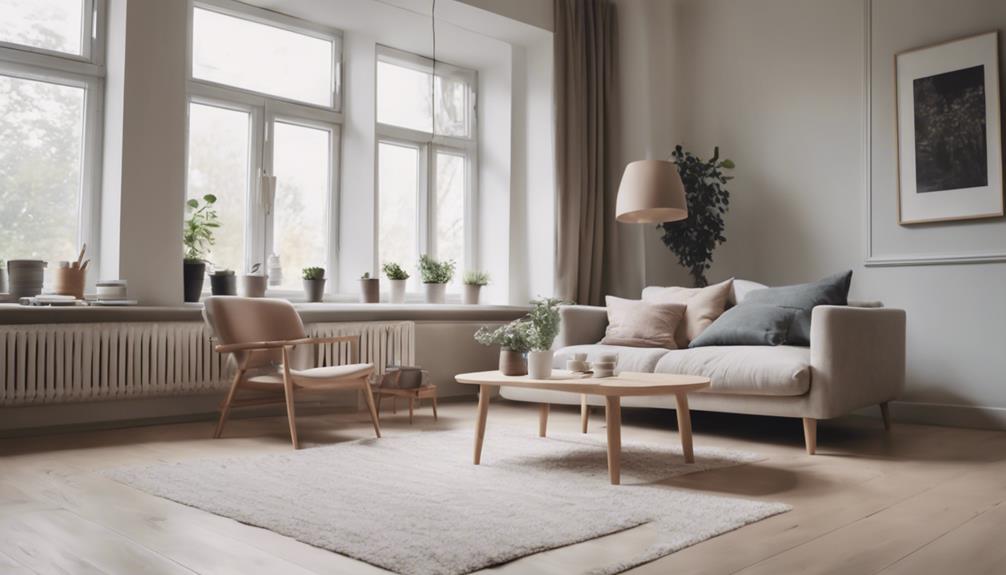
When choosing flooring in Scandinavian design, you'll find that light oak hardwood, reclaimed pine planks, and bamboo are top contenders.
These options not only highlight natural beauty but also support sustainability and a minimalist aesthetic.
Each choice adds to the overall feeling of warmth and openness that defines this style.
Light Oak Hardwood Flooring
Light oak hardwood flooring elevates Scandinavian design by maximizing natural light and fostering a bright, inviting atmosphere in your home. Its light oak hue aligns perfectly with the neutral tones commonly found in Scandinavian interiors, creating a soothing and cohesive aesthetic. This durability makes it an ideal choice for high-traffic areas, ensuring your space remains elegant even with daily wear.
The natural grain patterns of light oak add a subtle texture that contributes to the organic feel central to Scandinavian design principles. When you choose light oak, you're not just selecting a flooring option; you're enhancing the overall ambiance of your living space. It seamlessly blends with various decor styles, allowing you to incorporate vibrant accent colors or natural elements without clashing.
This flooring choice encourages a warm and welcoming environment, making your home feel more spacious and airy. By embracing light oak hardwood flooring, you're creating a balanced space that embodies the essence of Scandinavian design—minimalist yet inviting, functional yet stylish.
Enjoy the benefits of light oak as it transforms your home into a bright haven that reflects simplicity and sophistication.
Reclaimed Pine Plank Flooring
Embracing reclaimed pine plank flooring not only enhances the warmth of your space but also showcases the unique character and history of the wood. In Scandinavian design, this type of flooring is highly valued for its sustainable nature and the distinctive features it brings. You'll notice the knots and weathered textures that add an inviting touch to your interiors, creating a cozy atmosphere.
The natural hues of reclaimed pine, ranging from light yellows to deep browns, harmonize beautifully with the neutral color palettes typical in Scandinavian homes. This flooring not only elevates the aesthetic simplicity but also aligns with the principle of using natural materials, celebrating their evolution over time. As the wood ages, it develops a lovely patina, enriching your space further.
Additionally, installing reclaimed pine plank flooring can improve acoustics and insulation, contributing to the serene environment that Scandinavian design aims for. By choosing this flooring, you're not just making an eco-friendly decision; you're fostering a connection to nature, reflecting the Scandinavian value of harmony with one's environment. In doing so, you create a living space that feels grounded and inviting.
Bamboo Flooring for Sustainability
Bamboo flooring offers a sustainable and stylish alternative to traditional hardwood, perfectly aligning with Scandinavian design's emphasis on eco-friendliness and simplicity. As a rapidly renewable resource, bamboo can grow up to three feet in a single day and reaches maturity in just three to five years. This quick growth means you don't have to wait decades for trees to regrow, making bamboo a responsible choice for your home.
Bamboo flooring isn't only eco-friendly but also naturally resistant to moisture and pests. This durability means fewer chemical treatments are needed, enhancing its environmentally responsible credentials. Plus, with a variety of styles and finishes available, bamboo flooring can mimic the classic look of hardwood while maintaining the clean lines and functionality central to Scandinavian design principles.
When you're considering bamboo flooring, make certain to choose products certified by organizations like the Forest Stewardship Council (FSC). This guarantees that your flooring is sourced and produced in an environmentally responsible way.
Conclusion
Incorporating color psychology into your Scandinavian design can truly elevate your space.
By thoughtfully selecting key elements, essential fixtures, and lighting ideas, you can create a harmonious atmosphere that resonates with your style.
Don't forget to add decorative elements and choose the right flooring to complete the look.
Embrace the balance of functionality and aesthetics, and you'll find that the right colors can transform your home into a serene and inviting haven.
